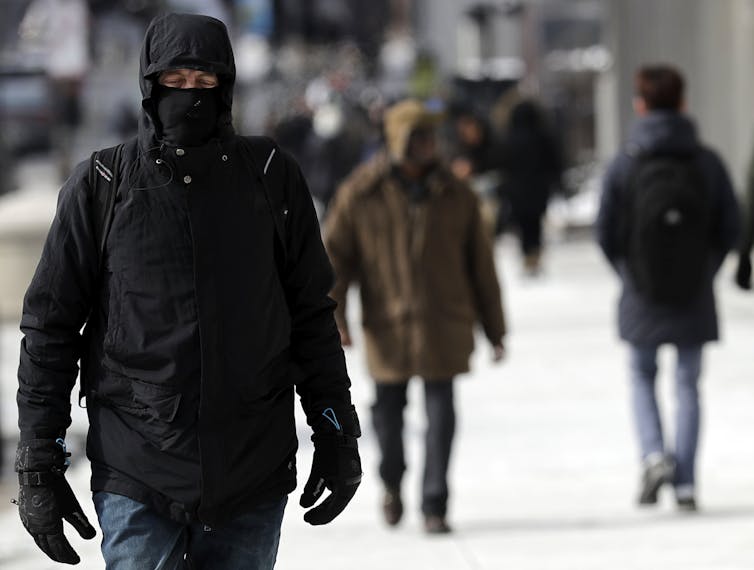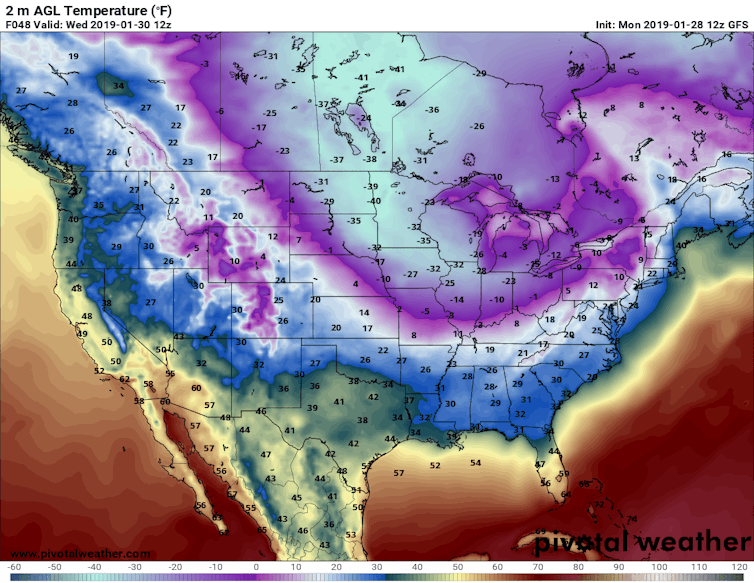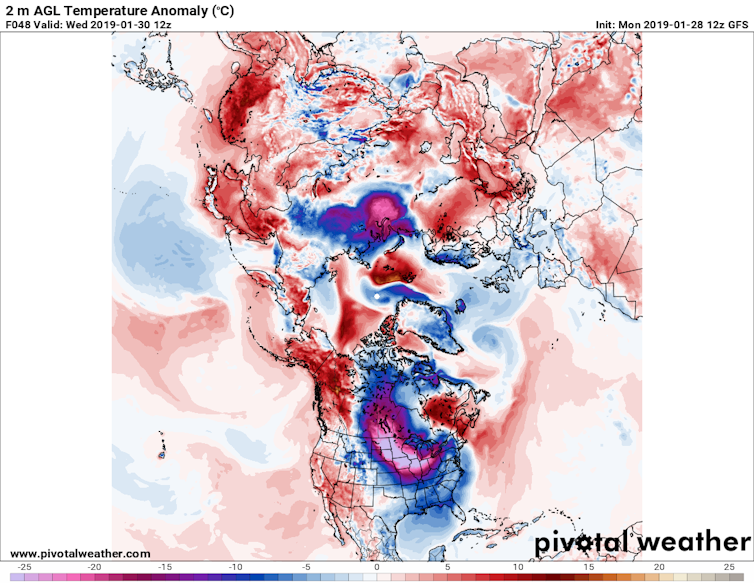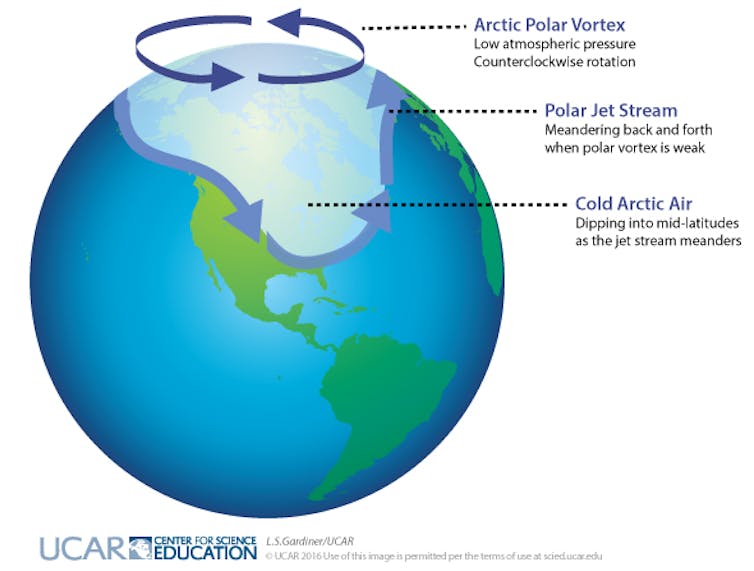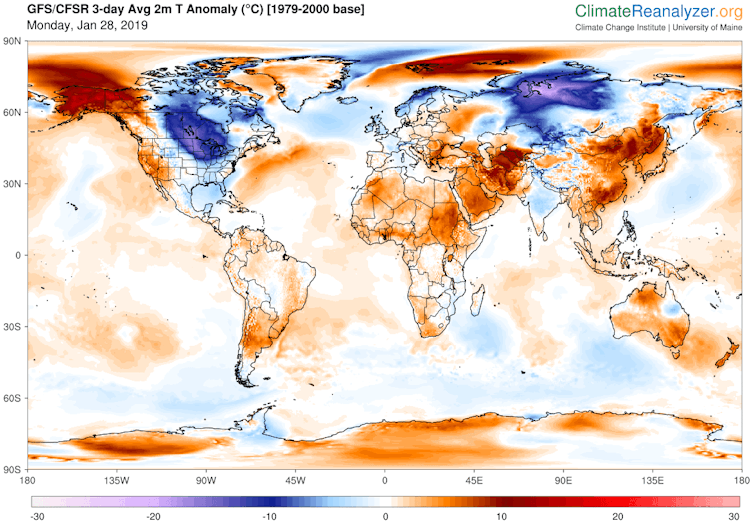 |
| Wind and temperature on February 8, 2020 at 18:00 UTC, near sea level (~100m, at 1000hPa) |
 |
| Wind on February 8, 2020 at 18:00 UTC, at 250 hPa (jet stream) |
So, why are stronger winds over the North Atlantic so dangerous?
Emissions by people heat up the air, which heats up oceans and makes winds stronger, in turn speeding up global ocean currents.
A recent study found increased kinetic energy in about 76% of the upper 2,000 meters of global oceans, as a result of intensification of surface winds since the 1990s.
As oceans heat up, more water evaporates from the sea surface. This evaporation will cool the sea surface somewhat, thus making that the sea surface can be colder than the water underneath the sea surface. Some of the water vapor will return to the ocean in the form of precipitation, but for each degree Celsius of warming, the atmosphere will hold 7% more water vapor, so much of the water vapor will remain in the atmosphere.
More water vapor in the atmosphere will further speed up global heating, since water vapor is a potent greenhouse gas.
Much of the water vapor will also get blown further along the path of the Gulf Stream in the direction toward the Arctic before precipitating, thus contributing - along with meltwater - to the formation of a cold freshwater lid at the surface of the ocean.
Stronger winds along the path of the Gulf Stream can make huge amounts of warm, salty water travel underneath this cold freshwater lid toward the Arctic, pushing up temperatures and salinity levels at the bottom of the Arctic Ocean and threatening to destabilize methane hydrates that are contained in sediments at the seafloor of the Arctic Ocean.
In summary, stronger winds can trigger huge eruptions of methane. Another recent study found that Arctic permafrost thaw plays a greater role in climate change than previously estimated. All this should be reason to take strong action to reduce this danger.
Emissions keep rising
Sadly, emissions show no sign of decline. The daily average CO₂ level at Mauna Loa, Hawaii was 416.08 ppm on February 10, 2020, higher than it has been for millions of years.
Since the annual peak is typically reached in May, even higher levels can be expected soon.
Indeed, the situation at Barrow, Alaska, doesn't look better, as illustrated by the image below, showing CO₂ levels up to February 13, 2020.
Very worrying is the rise in methane levels, as illustrated by the image below.
The image below shows methane levels at Barrow, Alaska, up to February 13, 2020.
High methane levels were recorded over the East Siberian Arctic Shelf (ESAS) by the MetOp-2 satellite on February 10 & 11, 2020, pm at 469 mb.
In the video below, recorded January 3, 2020, Guy McPherson and Josef Lauber discuss the track we're on.
Below is a video of an earlier discussion (February 25, 2019) between Guy McPherson and Josef Lauber.
The situation is dire and calls for immediate, comprehensive and effective action, as described in the Climate Plan.
Links
• Climate Plan
https://arctic-news.blogspot.com/p/climateplan.html
• News release: Global ocean circulation is accelerating from the surface to the abyss
https://www.eurekalert.org/pub_releases/2020-02/aaft-goc020320.php
• Deep-reaching acceleration of global mean ocean circulation over the past two decades - by Shijian Hu et al.
https://advances.sciencemag.org/content/6/6/eaax7727
• Arctic permafrost thaw plays greater role in climate change than previously estimated
https://www.colorado.edu/today/2020/02/03/arctic-permafrost-thaw-plays-greater-role-climate-change-previously-estimated
• The Arctic’s thawing ground is releasing a shocking amount of dangerous gases
https://www.nationalgeographic.com/science/2020/02/arctic-thawing-ground-releasing-shocking-amount-dangerous-gases
• Cold freshwater lid on North Atlantic
The image below shows methane levels at Barrow, Alaska, up to February 13, 2020.
High methane levels were recorded over the East Siberian Arctic Shelf (ESAS) by the MetOp-2 satellite on February 10 & 11, 2020, pm at 469 mb.
In the video below, recorded January 3, 2020, Guy McPherson and Josef Lauber discuss the track we're on.
Below is a video of an earlier discussion (February 25, 2019) between Guy McPherson and Josef Lauber.
The situation is dire and calls for immediate, comprehensive and effective action, as described in the Climate Plan.
Links
• Climate Plan
https://arctic-news.blogspot.com/p/climateplan.html
• News release: Global ocean circulation is accelerating from the surface to the abyss
https://www.eurekalert.org/pub_releases/2020-02/aaft-goc020320.php
• Deep-reaching acceleration of global mean ocean circulation over the past two decades - by Shijian Hu et al.
https://advances.sciencemag.org/content/6/6/eaax7727
• Arctic permafrost thaw plays greater role in climate change than previously estimated
https://www.colorado.edu/today/2020/02/03/arctic-permafrost-thaw-plays-greater-role-climate-change-previously-estimated
• The Arctic’s thawing ground is releasing a shocking amount of dangerous gases
https://www.nationalgeographic.com/science/2020/02/arctic-thawing-ground-releasing-shocking-amount-dangerous-gases
• Cold freshwater lid on North Atlantic
https://arctic-news.blogspot.com/p/cold-freshwater-lid-on-north-atlantic.html
• Carbon release through abrupt permafrost thaw - by Merritt Turetsky et al.
https://www.nature.com/articles/s41561-019-0526-0
• NOAA Global CH4 Monthly Means
https://www.esrl.noaa.gov/gmd/ccgg/trends_ch4
• Carbon release through abrupt permafrost thaw - by Merritt Turetsky et al.
https://www.nature.com/articles/s41561-019-0526-0
• NOAA Global CH4 Monthly Means
https://www.esrl.noaa.gov/gmd/ccgg/trends_ch4










































